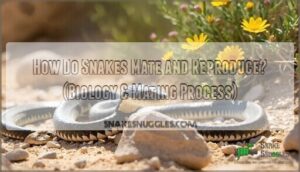This site is supported by our readers. We may earn a commission, at no cost to you, if you purchase through links.
 Most people picture snakes as solitary, mysterious creatures that keep to themselves—and they’re not wrong, except during breeding season when things get surprisingly social (and sometimes downright dramatic). Male snakes will literally wrestle each other for hours, females leave chemical trails that function like perfumed breadcrumbs, and in some species, dozens of males will form a writhing "mating ball" around a single female.
Most people picture snakes as solitary, mysterious creatures that keep to themselves—and they’re not wrong, except during breeding season when things get surprisingly social (and sometimes downright dramatic). Male snakes will literally wrestle each other for hours, females leave chemical trails that function like perfumed breadcrumbs, and in some species, dozens of males will form a writhing "mating ball" around a single female.
The mechanics of snake reproduction are just as fascinating as the courtship rituals, involving specialized anatomy that’s unlike anything you’d find in mammals or birds. From species that lay leathery eggs to those that give live birth—and even a few that reproduce without males at all—snakes have evolved an impressive variety of reproductive strategies that help them thrive in environments ranging from tropical rainforests to harsh deserts.
Table Of Contents
- Key Takeaways
- How Do Snakes Mate and Reproduce?
- What Are Snake Reproductive Organs Like?
- What Are The Main Snake Reproduction Methods?
- Do Snakes Provide Parental Care?
- How Do Environment and Species Affect Reproduction?
- Frequently Asked Questions (FAQs)
- How do male snakes get female snakes pregnant?
- Why do female snakes eat male snakes after mating?
- Do snakes knot when mating?
- Why do snakes form mating balls?
- Why do snakes mate in a ball?
- What is the mating pattern of snake?
- Do snakes stay together after mating?
- How do snakes even reproduce?
- How long does snake copulation typically last?
- Do male snakes compete for mating rights?
- Conclusion
Key Takeaways
- Male snakes have paired hemipenes (two reproductive organs) with species-specific shapes featuring spikes or hooks that lock during mating, which can last from minutes to hours and ensures successful sperm transfer.
- Female snakes possess specialized sperm storage tubules that keep sperm viable for up to seven years, allowing them to produce multiple clutches across seasons and selectively fertilize eggs with preferred males’ genetic material.
- Snakes use three main reproductive methods—oviparity (laying eggs), viviparity (live birth with placental structures), and ovoviviparity (eggs hatching internally)—with about 70% of species laying eggs and some even reproducing asexually through parthenogenesis.
- Snake courtship involves elaborate chemical communication through pheromone trails, intense male competition including wrestling matches and mating balls (where dozens of males swarm a single female), and species-specific rituals like chin-rubbing and tail quivering before cloacal alignment occurs.
How Do Snakes Mate and Reproduce?
Snake reproduction might seem straightforward, but there’s more going on beneath the surface than you’d expect. From chemical signals that lead males to potential mates to some truly unusual anatomical features, the mating process involves a fascinating sequence of behaviors.
Let’s break down how snakes actually find each other, compete for partners, and complete the physical act of mating.
Snake Courtship Behaviors and Rituals
When you picture snakes mating, you might imagine a quick, instinctive process—but the reality involves surprisingly elaborate courtship rituals that would make even the most romantic creatures take notes.
Male snakes engage in courtship displays like chin-rubbing along the female’s body, tail quivering, and even coital neck biting—snake mating behaviors that signal readiness and compatibility.
Sometimes males perform ritualized combat, wrestling each other to win access to females, occasionally forming a mating knot of tangled bodies competing for one partner.
Pheromone Trails and Mate Location
But before those elaborate displays can even happen, males need to find females in the first place—and that’s where pheromone trails become their secret weapon.
Females release chemical cues that drift through their environment, and males pick up these scent signals by flicking their tongues, which transfer particles to sensory organs in their mouths.
This trail marking lets males track down potential mates from impressive distances—a key part of snake reproductive strategies that kicks off the entire mating process.
Male Competition and Mating Balls
Once a male locks onto that pheromone trail, he’s rarely alone for long—other males often show up to the same spot, and that’s when things get competitive. Male rivalries kick in, and you’ll see wrestling matches where snakes intertwine and push each other around to establish dominance hierarchies.
In some species, multiple males form mating balls—tangled clusters of bodies all vying for access to a single female. These courtship displays aren’t just for show; they’re intense battles where the strongest or most persistent male usually wins breeding rights.
Alignment of Cloacae During Mating
After the winner of that competitive scramble earns his spot, the actual mechanics of snake mating come down to precise anatomical positioning—specifically, getting both cloacae lined up correctly. The male weaves his tail beneath the female’s in specific mating postures to achieve cloacal alignment.
Once positioned, he everts one of his hemipenes for intromission techniques that create a reproductive locking effect—sometimes called a mating knot—thanks to copulatory reflexes and the spiny structure of snake sexual anatomy, guaranteeing sperm transfer during the snake mating process.
What Are Snake Reproductive Organs Like?
Snake anatomy takes a surprising turn during reproduction. Male snakes have some unusual equipment, while females possess specialized systems for creating offspring. Let’s explore what lies beneath their scales.
Hemipenes: Structure and Function
Ever wondered how snakes mate with their unusual anatomy? The secret lies in their paired reproductive organs, called hemipenes—and they’re stranger than you might think.
Each male snake has two fully functional hemipenes inside his cloaca, but he uses only one during mating. Here’s the twist: hemipene shapes vary wildly across species. Some have spikes, hooks, or ridges that help the male stay anchored during mating.
This adaptation can extend copulation from minutes to hours, boosting the chances of successful sperm transfer in these legless reptiles.
Female Reproductive Anatomy and Sperm Storage
Female snakes have paired ovaries and oviducts, but the real marvel lies in the specialized sperm storage tubules nestled within the oviduct’s infundibulum. This feature showcases one of nature’s most remarkable fertility adaptations: sperm remains viable for up to seven years after a single mating.
- Ovarian follicles vary in size from 2.1 to 5.9 mm in diameter, swelling significantly during reproductive cycles.
- Sperm storage allows females to exercise cryptic choice, selectively fertilizing eggs with preferred males’ genetic material.
- Reproductive structures differ across species, with oviducts increasing by 80% in length during ovulation.
- Female genitalia include paired hemiclitores with erectile tissue, distinct from male hemipenes.
- Cryptic choice and the ability to store sperm from multiple males promote genetic diversity, enhancing evolutionary adaptability.
This storage capability lets females strategically delay fertilization, producing multiple clutches across seasons—or even switching between stored sperm and parthenogenesis when mates are unavailable. Snakes’ unique sperm storage ability is closely tied to their reproductive biology strategies.
Cloaca and Its Role in Reproduction
Think of the cloaca as nature’s Swiss Army knife—a single multipurpose opening tucked beneath the tail that manages everything from waste elimination to the intimate mechanics of snake reproduction.
During the snake mating process, cloacal alignment becomes critical—you’ll see males maneuvering into precise mating posture to achieve the reproductive orifice contact necessary for hemipenis function. This cloacal anatomy facilitates fertilization in reptile reproduction, with males everting one hemipenis directly into the female’s cloaca to deposit sperm.
What Are The Main Snake Reproduction Methods?
Snakes have evolved three main ways to bring their offspring into the world, each suited to different environments and survival strategies. Some lay eggs, others give live birth, and a few pull off something in between.
Let’s look at how each method works and why certain species have settled on their particular approach.
Oviparity (egg-laying) and Egg Incubation
When you think of egg-laying snakes, you’re seeing nature’s most common reproductive strategy—about 70% of all snake species lay their eggs in nests and then wait. Once the eggs are fully formed inside the female’s oviduct, she’ll search for humid spots—like rotting logs, leaf piles, or burrows—where her leathery-shelled clutch can incubate safely.
Here’s what happens during snake egg incubation:
- Eggshell structure allows oxygen exchange while preventing moisture loss
- Incubation periods vary widely, from 45 days to several months depending on species and temperature
- Nesting behaviors span from simple "drop and go" to careful site selection in oviparity
- Hatching processes involve hatchlings using an egg tooth to cut through their leathery shell
Temperature controls everything in reptile reproduction—warmer conditions speed up development, while cooler temps slow it down.
Viviparity (live Birth) and Embryo Development
Some snakes skip egg-laying altogether and give birth to live, wriggling babies—a feat that requires an internal system rivaling any mammal’s placenta.
In viviparity, embryo development happens entirely inside the mother, where specialized placental structures transfer nutrients and oxygen directly to growing fetuses.
This live birth method appears in roughly 20% of snake species—like garter snakes and boa constrictors—and proves especially handy in cooler climates where external eggs would struggle to stay warm enough.
Ovoviviparity (eggs Hatch Inside Mother)
Ovoviviparity sits right in the middle of egg-laying and live birth—females carry eggs inside their bodies, but those eggs hatch internally just before delivery, so out come fully formed baby snakes instead of shelled packages.
Here’s how ovoviviparous development works in the snake mating process:
- Embryo nourishment comes entirely from the egg’s yolk, not from maternal nutrition
- Internal egg hatching happens inside the mother’s oviduct right before birth
- Reproductive adaptations protect developing embryos from harsh external temperatures
- Females retain eggs until they’re ready to "hatch and deliver" simultaneously
This strategy combines viviparity’s protection with oviparity’s independence—perfect for species coping in unpredictable environments where external incubation might fail.
Parthenogenesis and Asexual Reproduction
Now for the wild card: snakes don’t always need a partner. Parthenogenesis lets females reproduce asexually, creating offspring without male contact—a handy reproductive assurance when mates vanish.
Species like green anacondas and Brahminy blind snakes pull off this trick, though it sacrifices genetic diversity for survival. Evolutionary benefits? Rapid population rebounds. The trade-off? Less adaptability when environments shift.
This unique ability ties back to parthenogenesis processes that help species survive.
Do Snakes Provide Parental Care?
Most people assume snakes just lay eggs and walk away, but the reality’s more interesting than that. Some snake moms actually stick around to protect their offspring, though the level of care differs greatly between species.
Let’s look at what different snakes do once their eggs are laid or their babies are born.
Egg Guarding and Incubation by Females
Not every snake mom walks away after laying her clutch—some species take their duties seriously, coiling protectively around their eggs like living incubators until the babies break free.
Female pythons wrap themselves around snake eggs, keeping them moist and regulating temperature through muscle contractions—a form of brood protection that directly boosts hatchling survival.
This maternal care during snake egg incubation shows that parental care in snakes isn’t as rare as you’d think.
Maternal Behaviors in Pythons and Vipers
Pythons and pit vipers don’t just sit on their eggs—they actively defend them, and some species even stick around to watch over their newborns for several days after they emerge.
This maternal care in pythons and vipers showcases real viper parenting and python nesting instincts—female snakes guard their vulnerable hatchlings, demonstrating that parental care in snakes extends beyond simple egg brooding into genuine protection of living offspring.
Feeding and Independence of Hatchlings
After the first few days under mom’s watchful eye, baby snakes are on their own—and they’re surprisingly self-sufficient.
Within 24 hours of hatching or birth, they’re ready to hunt and feed. What they eat as hatchlings depends on the snake species, but they quickly learn to forage independently.
These tiny snakes instinctively strike at prey, showing off feeding skills that don’t need any parental help. This quick shift to self-reliance reflects how snakes prioritize independence over extended parental care.
How Do Environment and Species Affect Reproduction?
Snake reproduction isn’t one-size-fits-all—it’s shaped by where a snake lives, what species it is, and whether humans are involved. Temperature swings and seasonal shifts act as nature’s alarm clock for breeding, while different species have evolved their own quirky reproductive tricks.
Let’s look at how these factors play out in the real world.
Temperature and Seasonal Breeding Cues
If you’ve ever wondered why your pet snake suddenly becomes restless in spring or why wild serpents seem to vanish during winter, the answer lies in their cold-blooded nature and the environmental clock that governs their entire reproductive cycle. As ectothermic creatures, snakes can’t regulate their body temperature internally—they’re entirely at the mercy of their surroundings.
Here’s how temperature cues and seasonal breeding triggers shape their mating behaviors:
- Spring warming signals "go time" – Rising temperatures kick-start feeding and courtship, with snakes often eating within 24 hours of warming to fuel reproduction.
- Winter dormancy resets the cycle – Cold periods trigger brumation, completely resetting their reproductive strategies and preparing them for the next mating season.
- Thermal regulation determines success – Without proper climate adaptation and environmental triggers, eggs won’t develop correctly and offspring survival plummets.
Temperature isn’t just a minor detail in the snake breeding process—it’s the master conductor orchestrating every phase of their reproductive strategies.
Unique Reproductive Traits in Different Species
Snakes show an incredible variety in how they reproduce. For example, flowerpot snakes are all female and reproduce asexually, creating offspring with three sets of chromosomes. Meanwhile, 80% of sea snakes give birth to live young, often in synchronized mass births.
Some marine snakes, like keelbacks, can lay over 40 eggs when resources are plentiful. Tropical snakes time their breeding based on food availability and their own fat reserves.
These strategies highlight how evolution has shaped each species to fit its specific environment.
Human Intervention and Captive Breeding Practices
Captive breeding programs in zoos are pushing the boundaries of snake reproduction. For example, ball python initiatives have successfully hatched over 5,000 eggs with an 81% success rate. Meanwhile, artificial insemination using frozen sperm has achieved a 30% hatch rate in Louisiana pine snakes.
These efforts rely on careful genetic diversity monitoring, tracking relatedness, and using microsatellite sequencing to avoid inbreeding. Techniques like cryopreservation now aid conservation, creating genetic reserves that help threatened species survive as wild populations decline.
Frequently Asked Questions (FAQs)
How do male snakes get female snakes pregnant?
Male snakes fertilize females during intercourse by inserting one hemipenis into her cloaca, transferring sperm.
After successful mating, females store sperm internally—sometimes for months—before fertilizing their eggs when conditions suit reproduction.
Why do female snakes eat male snakes after mating?
Here’s a plot twist: female snakes usually don’t eat males after mating. That’s actually a myth borrowed from praying mantises and spiders.
Female cannibalism in snakes is extremely rare, making post-coital death almost nonexistent in snake courtship rituals.
Do snakes knot when mating?
Snakes don’t knot during mating—no tangled pretzels here. Males use spiky hemipenes to stay locked in place.
Meanwhile, mating balls involve multiple males weaving around one female in a writhing mass of intermingled bodies.
Why do snakes form mating balls?
Imagine a writhing knot of dozens of amorous males—that’s the mating ball in action. This snake behavior happens when multiple males detect a single female’s pheromones and compete for reproductive success.
It’s organized chaos where male dominance and mating strategies collide in reptile mating’s wildest spectacle.
Why do snakes mate in a ball?
When several males discover the same receptive female, they compete by forming a mating ball—a tangled cluster of bodies where they vie for the best position to align their cloaca with hers during courtship.
What is the mating pattern of snake?
Like a carefully choreographed dance, snake courtship unfolds through chemical communication and physical displays. Males follow pheromone trails left by receptive females, then engage in rituals including chin-rubbing, tail quivering, and wrestling competitions before aligning their cloacae for mating.
Do snakes stay together after mating?
Most snakes don’t stick around after the mating process wraps up—there’s no mate fidelity or long-term pairing in snake reproduction.
Post-mating, these solitary creatures go their separate ways, showing minimal social behavior beyond courtship rituals.
Parental care in snakes, when it happens, is a solo act.
How do snakes even reproduce?
Fascinating flexibility defines snake reproduction. Depending on the species, they use oviparity (laying eggs), viviparity (live birth), or ovoviviparity (internal egg hatching).
Some snakes even practice parthenogenesis—reproducing without males—when mates aren’t available.
How long does snake copulation typically last?
Copulation duration differs widely by species, but most snake mating sessions last anywhere from a few minutes to several hours.
The mating process can extend even longer when multiple males compete, with some encounters stretching across days.
Do male snakes compete for mating rights?
Yes, male snakes compete fiercely for mating rights. During mating season, males engage in ritualized wrestling matches—weaving their bodies together in shows of strength.
These snake fights, sometimes called "mating dances," establish male dominance without serious injury, determining who’ll court the female.
Conclusion
Snakes, often seen as solitary creatures, reveal a surprising social side during mating season. Their reproductive strategies are as varied as the habitats they inhabit.
From intense wrestling matches to scent-based communication, snakes have mastered the art of reproduction. Whether laying eggs, giving birth to live young, or even reproducing without males, these reptiles showcase the adaptability and diversity of successful breeding.
It’s a testament to nature’s ingenuity that such seemingly simple creatures employ such complex and fascinating methods to ensure their survival.
- https://animals.howstuffworks.com/snakes/how-do-snakes-mate.htm
- https://redinational.com/what-preventative-measures-can-be-taken-during-snake-mating-season/
- https://talis-us.com/blogs/news/do-snakes-go-into-heat-exploring-snake-reproduction?srsltid=AfmBOor0l4PSbuD5BwagxhWcVb2Qk225WIO2OUdNNoUlHCvw-VkflkJi
- http://www.kingsnake.com/colubrid/2.html
- https://www.youtube.com/watch?v=62uNvfcNBj4












